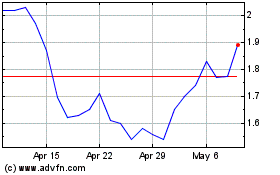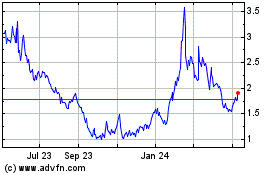Lexicon Pharmaceuticals, Inc. (Nasdaq: LXRX), today announced
topline data from four Phase 3 sotagliflozin studies in type 2
diabetes: SOTA-MONO, SOTA-SU, SOTA-GLIM and SOTA-INS. The final
results of these studies will be preserved for upcoming medical
congresses and publications.
“We are pleased with the evidence of robust A1C
reduction and long-term safety in patients with type 2 diabetes
demonstrated in these studies,” said Pablo Lapuerta, MD., executive
vice president and chief medical officer at Lexicon. “We look
forward to presenting and publishing detailed results from these
studies in the future.”
All four Phase 3 sotagliflozin studies met their
primary objectives of lowering A1C in patients with type 2
diabetes.
The observed safety profile of sotagliflozin in
these studies was generally consistent with that of approved SGLT2
inhibitors. Diarrhea, an event consistent with gastrointestinal
SGLT1 inhibition, was generally more common on sotagliflozin than
placebo, although it was not a meaningful cause of treatment
discontinuation. Genital mycotic infections were dose-related. The
absolute increase in the incidence of genital mycotic infections
over placebo ranged from 0% to 3.7% in studies of the 200 mg dose
and from 3.2% to 6.3% in studies of the 400 mg dose. In one study,
sotagliflozin showed less hypoglycemia than glimepiride, and in the
other three studies, the incidences of hypoglycemia in patients on
sotagliflozin were similar to those on placebo.
Lexicon does not intend to pursue any regulatory
approvals of sotagliflozin for type 2 diabetes in the absence of a
strategic partnership for the commercialization of sotagliflozin in
such indication.
Phase 3 SOTA-MONO Study
In the Phase 3, multicenter, randomized,
double-blind, placebo-controlled SOTA-MONO study, sotagliflozin 400
mg and 200 mg as monotherapy was tested for superiority versus
placebo in reducing A1C after 26 weeks of treatment in patients
with type 2 diabetes and inadequate glycemic control. The study
enrolled 142 patients on sotagliflozin 400 mg, 107 patients on
sotagliflozin 200 mg and 150 patients on placebo.
The study met its primary endpoint,
demonstrating that sotagliflozin 400 mg and 200 mg significantly
reduced A1C in patients with type 2 diabetes and inadequate
glycemic control on diet and exercise alone.
Safety results were similar to those in other
studies of sotagliflozin in type 2 diabetes, with similar
incidences of hypoglycemia on sotagliflozin and placebo.
Phase 3 SOTA-SU Study
SOTA-SU was a 507-patient, randomized,
double-blind, placebo-controlled, parallel group, multicenter Phase
3 study that evaluated the efficacy and safety of sotagliflozin 400
mg added to a sulfonylurea, alone or in combination with metformin,
in patients with type 2 diabetes who had inadequate glycemic
control on a sulfonylurea or metformin alone. The primary endpoint
was the change in A1C from baseline to Week 26. Patients were
followed for a total of 79 weeks.
The study met its primary endpoint,
demonstrating that sotagliflozin 400 mg significantly reduced A1C
in patients with type 2 diabetes who were on sulfonylurea alone or
in combination with metformin with inadequate glycemic control on a
sulfonylurea or metformin alone at Week 26. Importantly, A1C
reduction persisted through 79 weeks.
Safety results were similar to those in other
studies of sotagliflozin in type 2 diabetes. Mean estimated
glomerular filtration rate was estimated at Week 79, and was
similar for sotagliflozin and placebo. Despite the presence of
sulfonylurea background therapy, the incidences of hypoglycemia
were similar on sotagliflozin and placebo.
Phase 3 SOTA-GLIM Study
SOTA-GLIM was a 954-patient, randomized,
double-blind, double-dummy, active- and placebo-controlled,
parallel group, multicenter Phase 3 study that evaluated the
efficacy and safety of sotagliflozin 400 mg compared to glimepiride
or placebo added to metformin in patients with type 2 diabetes who
had inadequate glycemic control with metformin therapy. The primary
objective of the study was to demonstrate the non-inferiority of
sotagliflozin 400 mg compared to glimepiride on A1C at Week 52.
Patients were followed for a total of 52 weeks.
The study met its primary objective, as the
change from baseline in A1C reduction to Week 52 was the same on
sotagliflozin 400 mg and glimepiride, and the 95% confidence
interval excluded the pre-specified margin (0.3%) of
non-inferiority.
Safety results were similar to those in other
studies of sotagliflozin in type 2 diabetes, with less hypoglycemia
on sotagliflozin than glimepiride.
Phase 3 SOTA-INS Study
SOTA-INS was a 571-patient, randomized,
double-blind, placebo-controlled, parallel group, multicenter,
52-week Phase 3 study that evaluated the efficacy and safety of
sotagliflozin 400 mg and 200 mg or placebo in patients with type 2
diabetes who had inadequate glycemic control on basal insulin alone
or in addition to oral antidiabetic agents. The primary endpoint
was a change in A1C from baseline to Week 18. Patients were
followed for a total of 52 weeks.
The study met its primary endpoint,
demonstrating that sotagliflozin 400 mg and 200 mg significantly
reduced A1C in patients with type 2 diabetes who had inadequate
glycemic control on basal insulin alone or in addition to oral
antidiabetic agents. Importantly, A1C reduction persisted at the
same magnitude at 52 weeks.
Safety results were similar to those in other
studies of sotagliflozin in type 2 diabetes. Despite the presence
of background insulin therapy, the incidences of hypoglycemia were
similar on sotagliflozin and placebo.
About Sotagliflozin
Discovered using Lexicon’s unique approach to
gene science, sotagliflozin is an oral dual inhibitor of two
proteins responsible for glucose regulation known as sodium-glucose
co-transporter types 1 and 2 (SGLT1 and SGLT2). SGLT1 is
responsible for glucose absorption in the gastrointestinal tract,
and SGLT2 is responsible for glucose reabsorption by the kidney.
Sotagliflozin is approved in the European Union (EU) for use as an
adjunct to insulin therapy to improve blood sugar (glycemic)
control in adults with type 1 diabetes with a body mass index ≥ 27
kg/m2, who could not achieve adequate glycemic control despite
optimal insulin therapy.
About Lexicon
Pharmaceuticals
Lexicon is a fully integrated biopharmaceutical
company with a mission of pioneering medicines that transform
patients’ lives. Through its Genome5000™ program, Lexicon
scientists studied the role and function of nearly 5,000 genes and
identified more than 100 protein targets with significant
therapeutic potential in a range of diseases. Through the precise
targeting of these proteins, Lexicon is pioneering the discovery
and development of innovative medicines to safely and effectively
treat disease. In addition to its first commercial product,
XERMELO, Lexicon has a pipeline of promising drug candidates in
clinical and preclinical development in diabetes and metabolism,
oncology and neuropathic pain. For additional information, please
visit www.lexpharma.com.
Safe Harbor Statement
This press release contains “forward-looking
statements,” including statements relating to Lexicon’s long-term
outlook on its business, including the clinical development of, the
regulatory filings for, and the potential therapeutic and
commercial potential of XERMELO (telotristat ethyl), sotagliflozin,
and LX9211. In addition, this press release also contains forward
looking statements relating to Lexicon’s growth and future
operating results, discovery, development and commercialization of
products, strategic alliances and intellectual property, as well as
other matters that are not historical facts or information. All
forward-looking statements are based on management’s current
assumptions and expectations and involve risks, uncertainties and
other important factors, specifically including Lexicon’s ability
to meet its capital requirements, successfully commercialize
XERMELO, successfully conduct preclinical and clinical development
and obtain necessary regulatory approvals of telotristat ethyl,
sotagliflozin, LX9211 and its other potential drug candidates on
its anticipated timelines, achieve its operational objectives,
obtain patent protection for its discoveries and establish
strategic alliances, as well as additional factors relating to
manufacturing, intellectual property rights, and the therapeutic or
commercial value of its drug candidates. Any of these risks,
uncertainties and other factors may cause Lexicon’s actual results
to be materially different from any future results expressed or
implied by such forward-looking statements. Information identifying
such important factors is contained under “Risk Factors” in
Lexicon’s annual report on Form 10-K for the year ended December
31, 2019, as filed with the Securities and Exchange Commission.
Lexicon undertakes no obligation to update or revise any such
forward-looking statements, whether as a result of new information,
future events or otherwise.
For Investor Inquiries:
Kimberly Lee, D.O.Head of Investor Relations and
Corporate StrategyLexicon Pharmaceuticals(281)
863-3383klee@lexpharma.com
For Media Inquiries:
Chas SchultzExecutive Director, Corporate
Communications and Patient AdvocacyLexicon Pharmaceuticals(281)
863-3421cschultz@lexpharma.com
Lexicon Pharmaceuticals (NASDAQ:LXRX)
Historical Stock Chart
From Mar 2024 to Apr 2024

Lexicon Pharmaceuticals (NASDAQ:LXRX)
Historical Stock Chart
From Apr 2023 to Apr 2024
